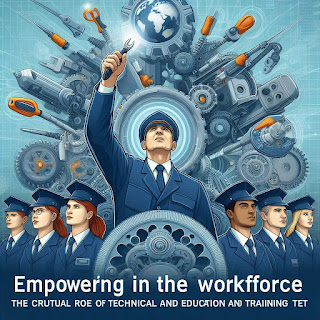“Empowering the Workforce: The Crucial Role of Technical and Vocational Education and Training (TVET)”
Introduction to TVET Technical and Vocational Education and Training (TVET) encompasses a wide range of learning experiences aimed at providing individuals with the skills necessary for employment in specific trades or professions.
This education is particularly focused on hands-on training and practical application, making it distinct from traditional academic education. ### Importance of TVET
1. **Employment Opportunities**: TVET programs are designed to meet the needs of the labor market, ensuring that graduates have the skills required by employers.
This alignment with industry needs often leads to higher employment rates among TVET graduates.
2. **Economic Development**: By providing a skilled workforce, TVET contributes to the economic growth of a country.
Skilled workers are essential for the development of industries such as construction, manufacturing, and technology.
3. **Personal Development**: TVET helps individuals develop practical skills that can lead to self-employment or entrepreneurship, providing them with the tools to create their own businesses and contribute to their communities. ### Examples of TVET Programs
1. **Engineering**: Programs in fields such as mechanical, electrical, and civil engineering provide students with the technical skills needed to design, build, and maintain infrastructure and machinery.
2. **Construction**: Training in construction trades, including carpentry, masonry, and plumbing, equips students with the skills to work on building projects, from residential homes to large commercial structures.
3. **Craftsmanship**: Courses in areas like welding, automotive repair, and electronics teach students the hands-on skills required to work in various technical and mechanical fields.
Global Perspective on TVET Many countries have recognized the importance of TVET and have implemented programs to support it.
- **Germany**: Known for its dual education system, Germany combines classroom instruction with on-the-job training, allowing students to gain practical experience while studying.
- **Australia**: Offers a wide range of TVET programs through Technical and Further Education (TAFE) institutions, providing students with qualifications that are recognized both nationally and internationally.
- **Somalia**: Organizations like the African Relief Committee (ARC) are actively involved in providing vocational training to youth and adults, helping them acquire skills in areas such as construction and water sanitation. ### Challenges and Solutions
1. **Funding**: One of the main challenges facing TVET programs is securing adequate funding. Governments and private sectors need to invest in these programs to ensure they have the necessary resources.
2. **Quality of Training**: Ensuring that the training provided is of high quality and meets industry standards is crucial.
This can be achieved through regular assessments and updates to the curriculum.
3. **Awareness and Perception**: There is often a stigma associated with vocational education, with many viewing it as a less prestigious option compared to academic education.
Raising awareness about the benefits and opportunities provided by TVET can help change this perception.
### Conclusion Technical and Vocational Education and Training plays a vital role in preparing individuals for the workforce, contributing to economic development, and providing opportunities for personal growth.
By addressing the challenges and promoting the benefits of TVET, countries can ensure that their workforce is equipped with the skills needed for the future




God
ReplyDelete